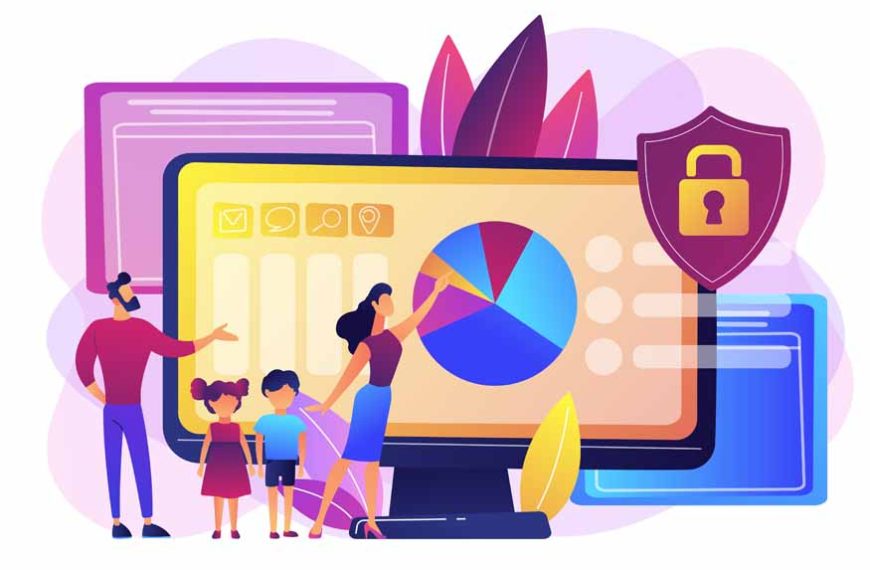The current learning process now requires the use of educational technology due to the rapid progress of the digital era. The integration of interactive platforms, educational applications, and virtual classrooms has fundamentally revolutionized students’ interactions with educational content. Even though these technological advancements have numerous benefits, parents and children still need to be aware of the risks and safety measures associated with educational technology. This article offers a comprehensive summary of the ideas that parents and children need to understand in order to help them navigate the world of online learning.
In an era where virtual classrooms and digital materials are ubiquitous, it is imperative to acknowledge the dual character of educational technology, encompassing both advantages and disadvantages. By delving into the positive impact of personalized learning experiences and increased accessibility while concurrently addressing concerns such as privacy issues and cybersecurity threats, parents and children can develop a nuanced understanding. As we embark on this exploration, the goal is to empower families with knowledge, equipping them to harness the benefits of educational technology while safeguarding against its inherent challenges.
Understanding the Benefits and Risks of Education Technology:
A multitude of advantages are provided by education technology, or edtech, such as more interactive involvement, enhanced accessibility, and personalized learning experiences. It does, however, come with some risks. Parental and child knowledge of the benefits and drawbacks of edtech is essential for informed decision-making.
1.1 Benefits of Education Technology:
- Personalized Learning:
- Increased Accessibility:
- Engaging Content:
Edtech allows for customized learning experiences, catering to individual students’ needs and preferences.
Technology breaks down geographical barriers, providing access to education for students in remote areas.
Interactive tools and multimedia resources make learning more interesting and engaging for students.
1.2 Risks and Concerns:
- Privacy Issues:
- Screen Time:
- Cyber Security Threats:
Edtech often involves the collection of personal data, raising concerns about privacy and data security.
Overuse of screens can cause sedentary behavior, sleep difficulties, eye strain, and other health problems.
Data breaches and phishing assaults are two cyber threats that can affect the digital world.
Establishing a Digital Literacy Foundation:
Maintaining safety in the virtual learning environment requires a strong foundation in digital literacy. The abilities required to appropriately navigate the digital realm must be taught to parents and kids.
2.1 Teaching Responsible Internet Use:
- Understanding Online Etiquette:
- Critical Evaluation of Information:
- Avoiding Cyber Bullying:
Educate children about appropriate behavior online, emphasizing the importance of respectful communication.
Teach children to critically assess online content for accuracy and reliability.
Discuss the implications of cyberbullying and encourage open communication if children encounter such situations.
2.2 Privacy and Security Education:
- Protecting Personal Information:
- Recognizing Online Threats:
Stress the value of maintaining the privacy of personal information and outline the possible repercussions of disclosing sensitive information.
Teach children to identify phishing attempts, scams, and other online threats that may compromise their security.
Implementing Effective Parental Controls:
Parents play a crucial role in creating a safe online learning environment. Implementing parental controls and monitoring tools can help ensure that children have a secure online experience.
3.1 Parental Control Features:
- Content Filtering:
- Screen Time Management:
- Monitoring Online Activities:
Set up filters to restrict access to age-inappropriate content.
Establish limits on screen time to prevent excessive device usage.
Use monitoring tools to track children’s online activities and identify any potential issues.
3.2 Open Communication and Supervision:
- Regular Check-ins:
- Supervision:
Maintain open communication with children about their online experiences, challenges, and concerns.
Monitor children’s online activities without infringing on their privacy, striking a balance between trust and guidance.
Choosing and Evaluating Educational Apps and Platforms:
The plethora of educational apps and online platforms available can be overwhelming. Parents should carefully select and evaluate these tools to ensure they align with educational goals and prioritize safety.
4.1 Researching Educational Apps:
- Reviews and Recommendations:
- Check Privacy Policies:
Read reviews from other parents and educators to gauge the effectiveness and safety of an educational app.
Review the privacy policies of apps and platforms to understand how they handle user data.
4.2 Evaluating Online Platforms:
- User Interface and Experience:
- Security Measures:
Choose platforms with user-friendly interfaces that enhance the learning experience.
Prioritize platforms that employ robust security measures, such as encryption and secure login procedures.
Promoting a Healthy Balance of Online and Offline Activities:
While education technology is a valuable tool, it’s essential to maintain a balance between online and offline activities to ensure the overall well-being of children.
5.1 Encouraging Physical Activities:
- Outdoor Playtime:
- Balanced Schedule:
Allocate time for outdoor activities to promote physical health and reduce the negative effects of prolonged screen time.
Create a balanced daily schedule that includes a mix of educational screen time, offline learning, and recreational activities.
5.2 Setting Realistic Expectations:
- Quality Over Quantity:
- Flexible Learning Approaches:
Emphasize the importance of the quality of educational activities rather than the quantity.
Recognize that different children may thrive with varying learning approaches, and flexibility is key.
Staying Informed About Digital Trends and Challenges:
The digital landscape is continually evolving, and parents must stay informed about emerging trends, challenges, and solutions to adapt and safeguard their children effectively.
6.1 Keeping Up with Technology Trends:
- Continuous Learning:
- Tech-Savvy Parenting:
Stay informed about new educational technologies and trends through reputable sources, conferences, and workshops.
Develop digital literacy skills as a parent to better guide and support children in their online learning journey.
6.2 Addressing Emerging Challenges:
- Cyber Security Updates:
- Adapting to Changes:
Stay abreast of cyber security threats and update security measures accordingly.
Be ready to adjust to modifications in the digital environment, such as alterations in the laws governing schooling or improvements in technology.
When utilised properly, educational technology may significantly improve children’s learning experiences. For children to securely navigate the digital realm, parents and kids must collaborate.
By understanding the benefits and risks of education technology, establishing a foundation of digital literacy, implementing effective parental controls, carefully choosing educational apps and platforms, promoting a healthy balance of online and offline activities, and staying informed about digital trends, parents can ensure that their children harness the full potential of technology while minimizing potential risks. Through collaboration and proactive measures, we can create a secure and enriching digital learning environment for the next generation.
Nurturing Social and Emotional Learning Online:
In the realm of education technology, it’s essential to recognize the significance of social and emotional learning (SEL). While digital platforms facilitate academic growth, they also offer opportunities to develop crucial social and emotional skills.
7.1 Fostering Digital Citizenship:
- Respectful Online Communication:
- Digital Empathy:
- Online Collaboration:
Teach children the importance of respectful and positive communication in online interactions.
Encourage empathy and understanding, emphasizing that there are real people behind digital profiles.
Foster collaborative skills by engaging children in group activities and projects within the online learning environment.
7.2 Addressing Social Challenges:
- Virtual Friendships:
- Dealing with Cyber Bullying:
Discuss the concept of online friendships and guide children on establishing healthy connections while maintaining boundaries.
Equip children with strategies to handle cyberbullying situations, emphasizing the importance of reporting any incidents.
Collaborating with Educators and Schools:
Parents and educators should form a collaborative partnership to ensure a seamless integration of education technology into the learning process. Open communication and shared goals are crucial for the holistic development of students.
8.1 Parent-Teacher Communication:
- Regular Updates:
- Parent-Teacher Conferences:
Stay in regular contact with teachers to understand the curriculum, upcoming assignments, and the technology tools being used.
Attend conferences to discuss the child’s progress, addressing any concerns related to the use of education technology.
8.2 Involvement in School Policies:
- Participate in Policy Discussions:
- Advocate for Safety Measures:
Actively engage in discussions about school policies related to technology use, offering valuable parental perspectives.
Advocate for the implementation of robust safety measures within the school’s digital infrastructure.
Recognizing and Addressing Technological Inequities:
As education technology becomes more prevalent, it’s crucial to acknowledge and address potential inequities in access to resources and devices. The digital divide can hinder some students’ ability to fully benefit from online learning.
9.1 Access to Technology Resources:
- Providing Devices:
- Internet Connectivity:
Advocate for initiatives that provide students with access to digital devices, ensuring that every child has the tools needed for online learning.
Address issues related to internet connectivity, exploring solutions such as community Wi-Fi initiatives or subsidized internet plans for families in need.
9.2 Supporting Technological Literacy:
- Technology Training Programs:
- Community Collaborations:
Support programs that provide technological literacy training for both students and parents, bridging the gap for those less familiar with digital tools.
Foster collaborations between schools, local businesses, and community organizations to enhance access to technology resources.
Monitoring and Adapting to Online Behavior Changes:
Children’s behavior in the digital realm can evolve as they grow and encounter new online experiences. Continuous monitoring and adaptation are key to addressing emerging challenges and ensuring a safe online environment.
10.1 Evolving Online Interests:
- Regular Conversations:
- Awareness of Online Trends:
Have regular conversations with children about their online activities, interests, and the platforms they use.
Stay informed about the latest online trends, games, and apps that might capture children’s interest.
10.2 Addressing Online Peer Pressure:
- Digital Peer Influence:
- Building Resilience:
Educate children about the concept of digital peer pressure and guide them on making responsible choices.
Teach resilience and coping strategies to help children navigate challenging online situations independently.
Encouraging Creativity and Critical Thinking:
While embracing education technology, it’s crucial to foster creativity and critical thinking skills. Merely consuming information is not enough; children should be encouraged to question, analyze, and create.
11.1 Interactive Learning Opportunities:
- Project-Based Learning:
- Coding and Programming:
Take advantage of the chance to learn via projects that encourage creativity, critical thinking, and problem-solving.
Teach kids how to code and programme so they can make their own digital material.
11.2 Balancing Consumption and Creation:
Content Creation Tools: Explore platforms that allow children to create content, such as digital storytelling apps or multimedia presentations.
- Questioning Mindset:
Encourage a questioning mindset, teaching children to critically evaluate information rather than passively consuming it.
In the ever-evolving landscape of education technology, ensuring the safety and well-being of children requires a multifaceted approach. Beyond the initial considerations of privacy, security, and responsible usage, parents must actively engage in their child’s digital journey. This involves fostering social and emotional learning, collaborating with educators, addressing technological inequities, monitoring online behavior changes, and promoting creativity and critical thinking.
As we navigate the complexities of the digital era, it becomes evident that the role of parents extends beyond that of mere supervisors; it transforms into that of mentors and guides in the digital realm. Parents may enable their children to become responsible digital citizens who can fully utilize educational technology while minimizing its hazards by fostering in them a comprehensive grasp of technology and its ramifications.
Together, parents, teachers, and the larger community can build an educational environment that values each child’s safety, well-being, and holistic development in addition to embracing technology improvements. Together, let’s traverse the digital terrain with awareness, flexibility, and a dedication to creating a safe and secure future for today’s and tomorrow’s students.
For more such interesting blogs, Visit EuroKids
















